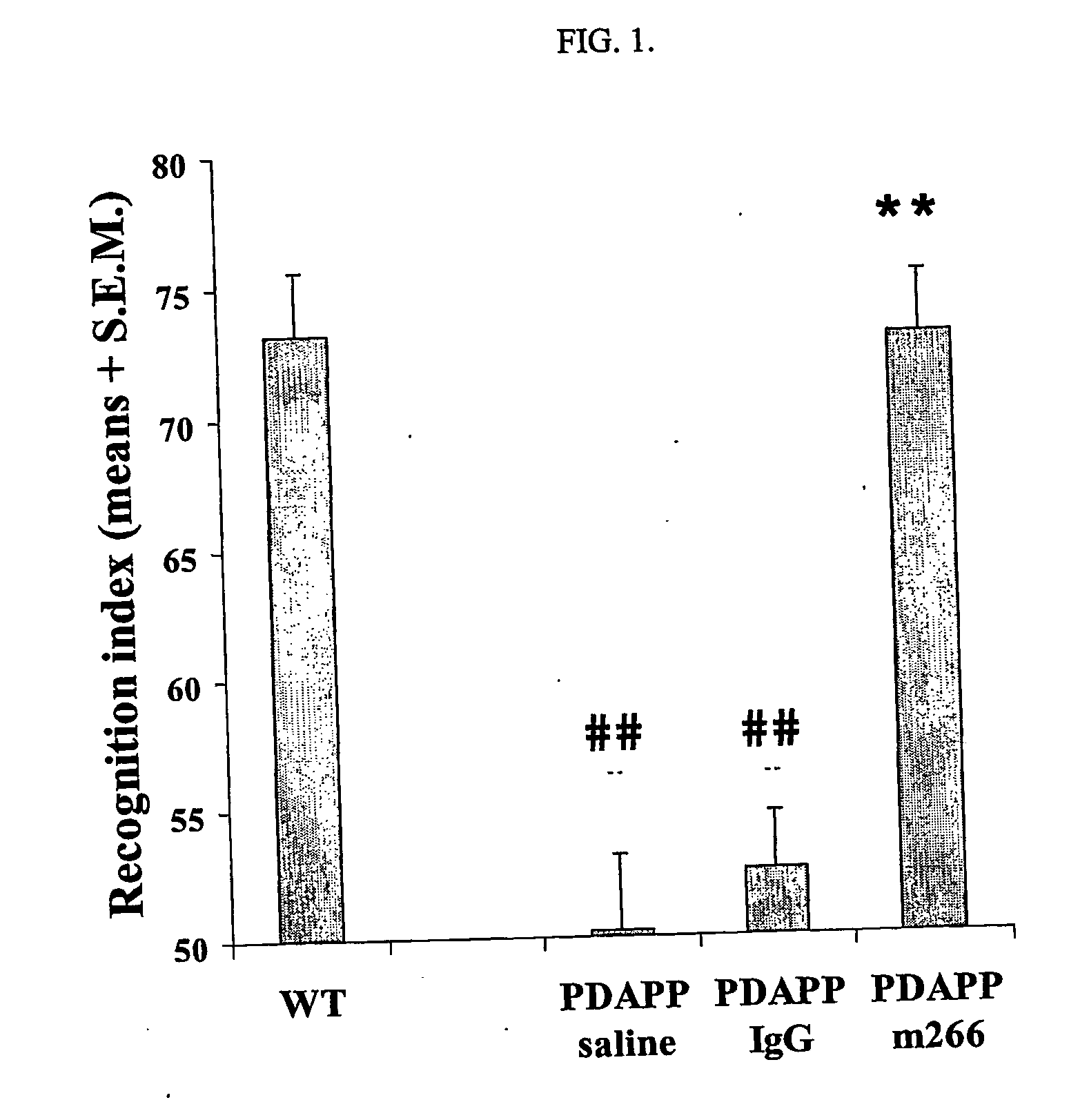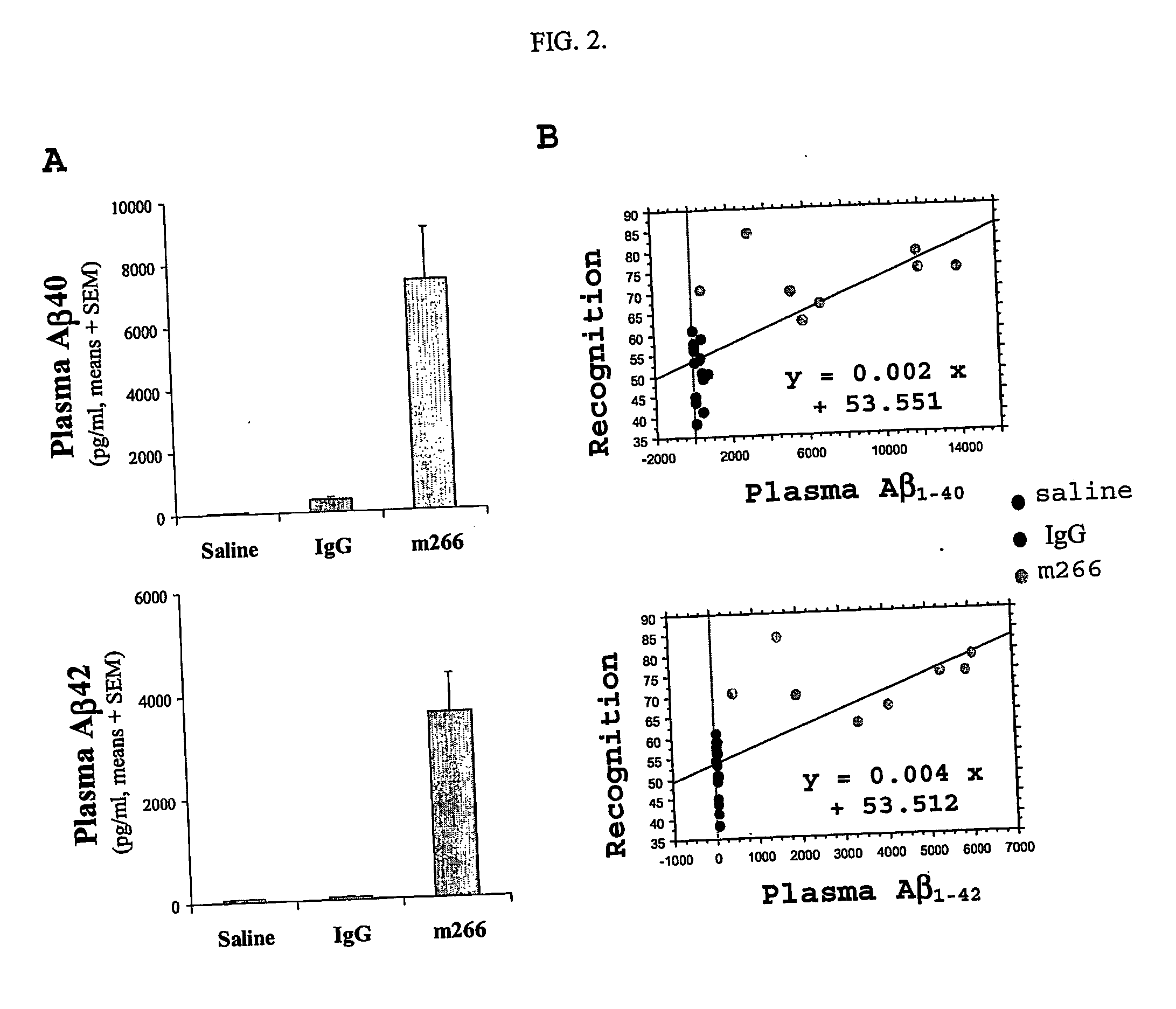Rapid improvement of cognition in condition related to abeta
a technology of abeta and cognition, applied in the field of medicine, can solve the problems of significant increase in the prevalence of dementia, dramatic increase in the cost of care, and breaking point when family members are no longer able to continue to provide care, and achieve the effect of rapid improvement of cognition
- Summary
- Abstract
- Description
- Claims
- Application Information
AI Technical Summary
Benefits of technology
Problems solved by technology
Method used
Image
Examples
example 1
Rapid Improvement in Cognition after Administration of Anti-Aβ Antibody 266
[0144] APPV717F transgenic mice (PDAPP mice, eleven month old) were used [Games, et al., Nature 373:523-527 (1995)]. The mice were handled daily 5 days before the behavioral testing. All animals had free access to food and water. They were housed at a room temperature of 23±1° C. and with a light-dark cycle of 12:12 h with lights on at 6:00 a.m. Behavioral experiments were conducted during the light period, between 8:00 a.m. and 2 p.m.
[0145] The object recognition task is based on the spontaneous tendency of rodents to explore a novel object more often than a familiar one [Ennaceur et Delacour, Behavioral Brain Research. 31:47-59 (1988); Dodat et al., Neuroreport. 8:1173-1178 (1997)]. This task was performed in a black Plexiglas™ open field (50×50×40 cm). The objects to be discriminated were a marble (1.5 cm diameter) and a plastic dice (1.8 cm edge). After each trial, the objects were handled with disposab...
example 2
Rapid Effect of Administration of Anti-Aβ Antibodies on Common Correlated with Affinity for Soluble Aβ
[0157] The anti-Aβ murine antibodies 21F12 (recognizing Aβ42, but not Aβ40), 2G3 (recognizing Aβ40, but not Aβ42), 4G8 (binding Aβ between 13 and 28), 10D5 (recognizing 1-16), and 3D6 (binding 1-5) are administered to transgenic PDAPP mice as described above.
[0158] The performance of the mice administered these antibodies is then determined in the object recognition test as described above. Performance will correlate positively with the affinity of the antibody of soluble Aβ, that is, the higher the affinity of an antibody for soluble Aβ, the generally higher will be the performance in tests of cognition within a short time after administering the antibody.
[0159] Antibody m266 causes more significant flux of Aβ into the plasma and faster, more complete recovery of object recognition than does an antibody such as 3D6, which has an affinity for soluble Aβ that is about 1,000-fold le...
example 3
Spatial Learning in APPV717F Mice Following a Single Anti-A§ Antibody Treatment
[0160] The subjects were female APPV717F and wild-type mice approximately 11 months old. Each mouse was administered 355 μg of murine 266 antibody or vehicle (PBS) administered 24 hours prior to start of testing (i.p.) Mice were tested in a holeboard spatial learning assay for four consecutive days (FIG. 3). Four holes were baited with access to a single food pellet and the remainder of the holes were baited beneath a screen without access. Mice were food-deprived each night before testing the next morning. Mice were tested for four, 180-second trials per day. Testing occurred for four consecutive days.
[0161] A single dose of Aβ antibody (266) significantly enhanced cognitive functioning of 11 month-old APPV717F mice compared to vehicle-treated transgenic mice (FIG. 4).
[0162] A significant decrease in total errors was noted on Day 4 for vehicle-treated WT mice while the number of errors was similar acr...
PUM
| Property | Measurement | Unit |
|---|---|---|
| time | aaaaa | aaaaa |
| time | aaaaa | aaaaa |
| concentration | aaaaa | aaaaa |
Abstract
Description
Claims
Application Information
 Login to View More
Login to View More - R&D
- Intellectual Property
- Life Sciences
- Materials
- Tech Scout
- Unparalleled Data Quality
- Higher Quality Content
- 60% Fewer Hallucinations
Browse by: Latest US Patents, China's latest patents, Technical Efficacy Thesaurus, Application Domain, Technology Topic, Popular Technical Reports.
© 2025 PatSnap. All rights reserved.Legal|Privacy policy|Modern Slavery Act Transparency Statement|Sitemap|About US| Contact US: help@patsnap.com



